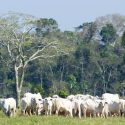Fighting ash borer: To spray or not to spray?
Perhaps the only good news in the Aug. 4 announcement that emerald ash borers have been found in southeastern Wisconsin is that the invasive pest took its time getting here.
In the six years since the wood-boring beetle was first spotted in Michigan, several new tools have emerged for wiping out the insect and sparing the ash trees it feasts upon.
But so, too, has confusion about when and how to deploy those tools. Should landowners treat any ash tree, or only those in infested areas? And which strategy works best?
“There’s a lot of misinformation out there right now,” says Chris Williamson, a University of Wisconsin–Madison associate professor of entomology and an insect-control specialist for UW-Extension. “It’s critical to get correct information before you make a decision.”
Williamson says researchers in Michigan and Ohio, who have been studying ways to combat the beetle since it first arrived in 2002, have found that several types of pesticides can be effective in controlling emerald ash borer. One of the most thoroughly tested is a compound called imidacloprid, which is an active ingredient in both professional and over-the-counter pesticides. Imidacloprid is a neurotoxin that kills insects as they bore through trees, and it is usually applied once a year by pouring or injecting the pesticide into soil surrounding affected trees.
A more recent addition to the arsenal is the chemical emamectin benzoate, which is typically injected into the bark of a tree. Marketed under the name Tree-Age, this new pesticide has shown impressive potency in early trials, but Williamson cautions that there is not yet enough data to suggest that it is a better alternative to lower-cost, less-invasive options.
“We’ve heard of some people going door-to-door in Ozaukee County and telling people that this is the only way to save their trees,” says Williamson. “That’s really misleading. They’re cherry-picking data to make that statement.”
The manufacturers of the active ingredient in Tree-Age also have yet to apply for approved use in Wisconsin, although they are expected to do so soon.
Because North American ash trees have no known natural resistance to emerald ash borer, a native of Asia, no approach is fail-safe. Williamson says that pesticides have been shown to be more effective in protecting smaller trees and those that have not yet been heavily infested by the insects. “If you have a greater than 40 percent dieback in the canopy, it’s not in your best interest to try any kind of rescue treatment,” he says. “At that point, it’s very difficult for that tree to recover.”
But Williamson stresses that for homeowners in most parts of the Wisconsin, the best approach right now is likely to do nothing. Although emerald ash borers have spread to 10 states and killed 25 million trees throughout the upper Midwest, the insects don’t travel very far on their own. Mostly, they get a free ride from humans through the transportation of firewood and other infested wood products. Shortly after the beetle was discovered in Ozaukee and Washington counties, Wisconsin state officials blocked the shipment of firewood and other ash products from the area to prevent this human-aided spread, meaning that most of Wisconsin’s more than 740 million ash trees are likely out of harm’s way for now.
“We have very good research data that shows the area of highest risk is within 10-12 miles of a known infestation,” says Williamson. “Outside of that area, I really don’t think there’s a need to treat.”
Williamson’s final piece of advice is to maintain perspective. While the damage caused by emerald ash borer throughout the Midwest warrants concern, he says at this time of year the insects are not in a mobile stage. “We have time-probably until next May, before the adult insects begin to fly-to make an informed and appropriate management decision,” he says.
In the meanwhile, two Web sites from state and campus sources are tracking and posting updated information on the insects. UW-Extension’s network of county extension agents also work with specialists such as Williamson to bring research-based information to respond to communities’ and landowners’ concerns.



